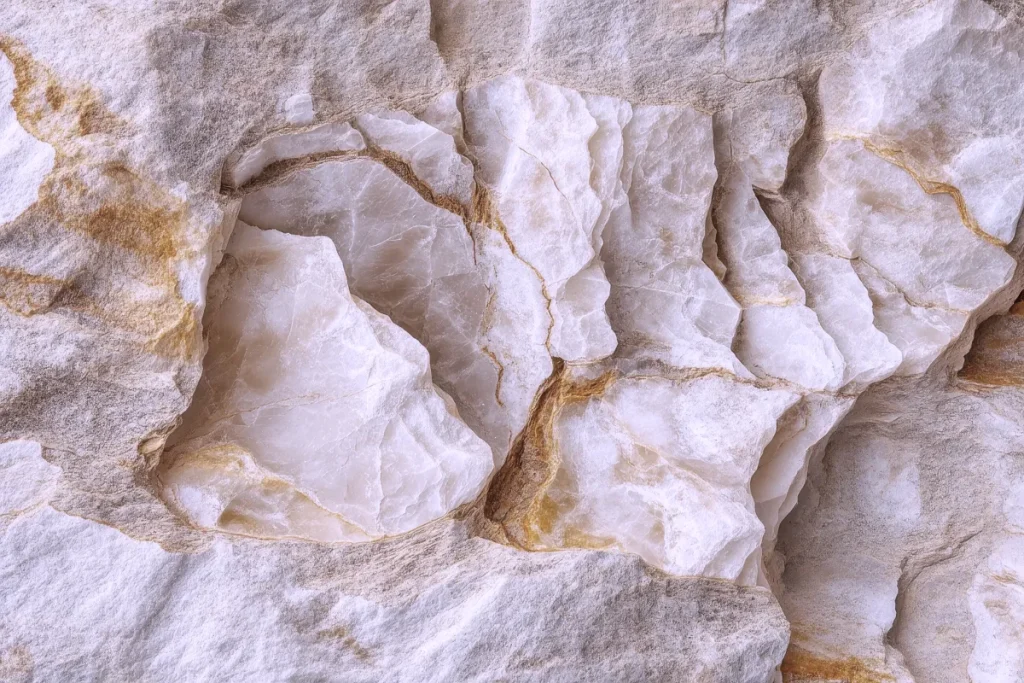Alabaster is much more than just a mineral; it is a remnant of time, a tangible trace of the geological processes that shaped the Earth millions of years ago. Its history begins in a prehistoric sea that existed during the Oligocene, and its journey from formation to its current use in design and sculpture makes it an invaluable resource for both architecture and the arts. In this article, we will explore the fascinating origins of alabaster and its role in human creativity.
The Origin of Alabaster: A Geological Tale
The most widely accepted scientific theory about the origin of alabaster takes us back to the Oligocene, a geological epoch that occurred more than 30 million years ago. During this period, a large endorheic basin was trapped between the Pyrenees, the Iberian System, and the Catalan Coastal Range. This basin, once an inland sea, gradually dried up, creating the necessary conditions for the formation of alabaster in what we now know as the Ebro Valley.
The process began with the crystallization of gypsum, a mineral composed of hydrated calcium sulfate (CaSO₄·2H₂O). Over time, the pressure exerted by accumulated sediments on these gypsum crystals caused their transformation into anhydrite (CaSO₄), a denser mineral without water in its composition.
After millions of years and the ongoing effects of erosion and water, the sediments covering the anhydrite were gradually removed, relieving the pressure it was under. This release allowed the anhydrite to slowly rehydrate, forming small nodules of finely crystallized gypsum: alabaster, as we know it today.
The Ebro Valley: Cradle of Alabaster
Although alabaster can be found in various parts of the world, the Ebro Valley is the world’s main supplier of this mineral. The unique combination of geological and climatic conditions in this region has been crucial for the preservation and formation of alabaster over millions of years. The area’s extreme aridity has preserved the alabaster deposits, allowing the region to remain the primary source of this resource today.
Currently, almost all the alabaster used globally comes from this enclave. Its translucent whiteness and fine crystallization make it ideal for various artistic and architectural applications. However, its value lies not only in its physical beauty but also in the geological history it holds, connecting the deep past of the Earth with our hands and our homes.
Alabaster in Art and Architecture
Alabaster has been valued since ancient times for its versatility and ease of work. In ancient Egypt, it was used to create statues and funerary vessels; during the medieval period, it adorned cathedral windows, thanks to its ability to diffuse soft light. Today, it remains a prized material in the world of art and design.
In interior design, alabaster is used to craft everything from lamps to countertops, adding a touch of elegance and refinement. Its ability to transform light into a warm, soft glow makes it a popular choice for creating cozy atmospheres. In sculpture, its softness allows artists to carve detailed forms, creating pieces that appear almost ethereal due to the material’s delicate nature.

A Bridge Between the Past and the Present
Alabaster is much more than a natural resource. It is a bridge between the geological history of the Earth and human creativity, a testament to the processes that have shaped the planet and how humanity has harnessed these gifts of nature to create beauty and functionality.
From the depths of the Ebro Valley to our homes and workplaces, alabaster connects us to a distant past while inviting us to appreciate its uniqueness and versatility in the present. Every piece of alabaster that is sculpted or integrated into interior design carries with it a story of geological transformation and an artistic legacy that has endured through the centuries.
Conclusion
The journey of alabaster, from its origins in a prehistoric sea to its use in modern sculpture and design, reflects its uniqueness and value both geologically and creatively. This mineral, primarily extracted from the Ebro Valley, remains a testament to the interaction between nature and humanity, connecting our present with a past that stretches back millions of years. In its beauty and versatility, alabaster continues to hold a prominent place in architecture and the arts, reminding us of the importance of cherishing the treasures that the Earth offers.
